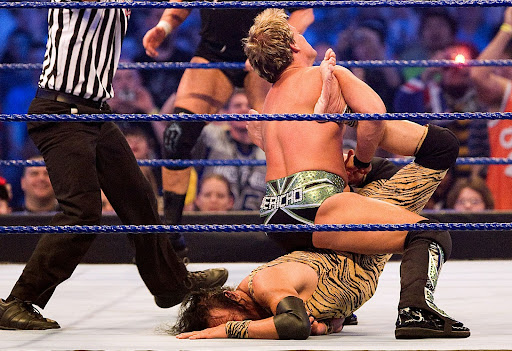
Why is wrestling the most traumatic sport?
FiveThirtyEight.com (data journalism, they do clear and up-to-date infographics) has rolled out some scary statistics on early deaths in American professional sports. It turns out that the WWF (World Wrestling Federation, now WWE) has the most alarming numbers.
Furthermore, while the difference between the NBA, NFL, MLB, and NHL is not that big, the WWE surpasses them all by times in every age group. Bottom line: one of the leading causes of such severe consequences is trivial concussions. Over time, they lead to dementia and other dire consequences. If you want to start playing one of these sports, then the games in the club Bollywood will be a great solution. The free online casino games are absolutely harmless to your health, unlike offline entertainment.
Wrestling is a show, and they do not hit, do they?
It is a misconception. First, you must understand that some moves cannot be performed realistically without hitting. For example, with a chair, sticks, bottles, and other props, you get hit in the head for real.
Here is an explanation from Chris Jericho (one of the greatest wrestlers of our time, now the star of the new wrestling federation, AEW):
“Wrestling is not a movie. You cannot repeat some punches several times, do a couple of takes, and then put the sound on. We have no right to make a mistake because the viewer will quickly lose faith in what is happening if we do not finish. That is why sometimes we have to hit it pretty hard.
Like with me and Adam Page, I had to attack him after the match, and with a piece of equipment, maybe a shoe insert, I split Adam’s eyebrow. The blood flooded all over the ring. We didn’t plan for that, but luckily Paige reacted like a pro, and the episode went on, and the audience loved it.”
Secondly, wrestling doesn’t follow the same rules, and each organization has its own rules. For example, in Asia, a rugged style is widespread, and its peculiarity – full-contact fight, the punches are accurate. At the last moment, the kicker extinguishes force. But very often, the blows are real, and it all depends on the opponent’s stamina.
Even the most straightforward moves can be dangerous.
The legendary Hulk Hogan (IGN named Hulk Hogan the most recognizable wrestler in history and the most popular wrestler of the 1980s) suffered from back pain and leg pain. He could not even walk properly due to a leg drop (when a wrestler drops his legs on his opponent from his height).
Logically, the more spectacular the technique is, the more complicated it is. To master it, you must practice; that’s why you can’t go anywhere without “Botch.”
But sometimes it’s not funny. For example, in AAA in Mexico, Rey Mysterio (multiple WWE Champions in different categories, a living legend of Mexican wrestling) sent Perro Aguayo to the ropes; he landed badly and hurt his cervical vertebrae.
At first, his condition was taken as part of the show; Mysterio performed his finisher, the crowning move, after which, as you can tell from the name, the match is usually over. But then Ray realized something wasn’t right. Then, unfortunately, Perreault passed away in the hospital.
That’s clear, but what is the high mortality rate after the end of a career?
The main danger of dementia arising from frequent concussions is its gradual progression. It is based on repeated concussions and two syndromes: PCS and CTE.
Post Concussion Syndrome (PCS) is the long-term effects of one or more concussions. The victim may complain of headaches, nausea, weakness, a “heavy head,” disorientation, impaired memory, speech, and so on. These symptoms are characteristic of a new concussion but sometimes appear months or even years after the injury.
How does it happen?
Our brain is something like jelly. Unlike it, it does not have a homogeneous structure, but is an entanglement of many neurons. To simplify, the brain can be described as a big ball of gelatinous threads.
The skull protects it from many traumatic influences, but when a blow is strong enough, the brain structures can shift slightly and hit the walls of the head, which provokes brain damage. If you pour jelly into a pot, tap it, and then plug it hard, the jelly will ripple somewhere, moving away from the walls and banging against them. It’s the same story with the skull and the brain in it.
On a micro level, it causes neural connections – the gelatinous threads of our brain ball – to break. Damage can both slow down and interrupt the transmission of nerve impulses entirely; it depends on the amount of wear and its localization, which causes the above symptoms.
And the more such damage, the greater the likelihood of developing PCS.
Chronic Traumatic Encephalopathy (CTE) is chronic post-traumatic encephalopathy. It doesn’t sound straightforward, but it will be evident using the same analogy as PCS.
CTE is the even more distant effect of concussions. This can be thought of as a sequence: concussion -> multiple concussions -> PCS -> CTE.
Translated into human language – it is a pathology of the brain, as a result of which its cells gradually change and die off; if I may say so, the brain shrinks with age and new traumas.
Of course, this does not happen overnight. Cognitive functions decline gradually; at first, the memory begins to suffer, and there are unmotivated mood swings and headaches; the person starts to degrade before his eyes and, over time, loses the ability to even care for themselves, which is called dementia.
Unfortunately, it is impossible to say precisely when the repeated concussions will develop into PCS and how severe the manifestations of CTE will be. Therefore, various methods and markers for assessing brain damage are now being sought.
In particular, a specific protein was discovered, which is elevated in the blood when the central nervous system is damaged. Still, it was later found that it could be elevated for many other reasons, and the method was not as accurate as we would like it to be.
Where did such a scary statistic come from?
It’s a combination of several reasons:
- CTE is a relatively young disease, meaning all the dangerous admissions and multiple untreated concussions happened before rule changes and other preventative measures.
- WWE owner Vince McManus is the most stubborn and conservative man in the industry but also the most influential. Hardcore fans and many wrestlers hate him, but as long as WWE is a monopoly – Vincent will make decisions on his own, and they are far from always in step with the times.
- Loopholes in company policy itself. The strict requirements of the “wellness policy” do not apply to stars who do not have a permanent contract. It, for example, allowed Brock Lesnar to perform completely quietly in WWE after the scandal in 2016 – when Brock was already preparing for a title fight in the UFC after knocking out Hunt but got caught doping. The fight’s result was annulled, with a one-year ban from all competitive sports.
Only the WWE and several other significant federations have decent salaries and their medal counts. The smaller ones don’t have health programs or money for good insurance.
Wrestlers, like other athletes, often sacrifice their health on their way to the top. So get back in the ring as soon as possible, get more screen time, and win new titles.







